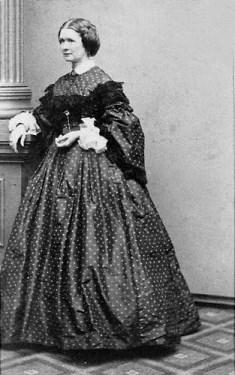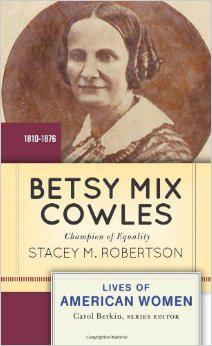First Woman Eye Surgeon and Prison Reform Activist Image: Dr. Bella Chapin Barrows Credit: Hartland Historical Society Artist unknown Dr. Bella Chapin Barrows accomplished many firsts in her 68 years of life. She was the first woman employed by the U.S. State Department, first woman to have a private medical practice in Washington DC, first woman ophthalmologist (a specialist in eye ailments) in the United States, first woman eye surgeon, and first woman professor at a medical school (Howard University). Early Years Born Isabel Hayes April 17, 1845 in Irasburg, Vermont to Scottish immigrants Dr. Henry Hayes and Anna Gibb Hayes. Young Isabel – called Bella by everyone – helped her father on house calls by tending to wounds and…

Mary Easton Sibley
Pioneer in Education in Early Missouri Mary Easton Sibley was an early American pioneer and educator. In 1830, she and her husband founded a girls’ school in St. Charles, Missouri that would become the Lindenwood College for Women, the first women’s college west of the Mississippi River. Today, Lindenwood University is a major coeducational institution that continues to honor Sibley and her dedication to education for women. Image: Map of the Louisiana Purchase Including exploration routes of the early 1800s Early life Mary Easton was born January 24, 1800 in Rome New York, the first of eleven children born to Rufus Easton and Alby Smith Easton. In 1804, President Thomas Jefferson appointed Rufus Easton territorial judge of the Louisiana Territory,…
Susan McKinney Steward
First African American Woman Doctor in New York Only five years after the Thirteenth Amendment to the Constition abolished slavery in the United States, Susan McKinney Steward graduated from medical school and became the first African American woman physician in New York and only the third black female doctor in the country. She practiced medicine in Brooklyn and Manhattan most of her life. Early Years Susan Maria Smith was born in Brooklyn, New York in the year 1847. She was the seventh of ten children born to Sylvanus and Anne Springstead Smith, who were both multi-racial. Her mother was the daughter of a Shinnecock Indian woman and a French colonel. Her father’s ancestors included a Montauk Indian and an African…

Underground Railroad in Pennsylvania
Pennsylvania Conductors Led Slaves to Freedom Abolition of slavery was the great moral issue of the nineteenth century, especially after the passage of the Fugitive Slave Law of 1850, which allowed owners to capture their slaves in free northern states and return them to the South. The Underground Railroad (UGRR) was a loose grouping of people who risked home and safety to help runaways escape bondage. The penalties for their actions were severe. If caught, a stationmaster on the UGRR could be jailed and fined $20,000, a huge sum at that time. The Constitution of the United States had a fugitive slave clause that Congress implemented with the first Fugitive Slave Law in 1793, placing a fine on anyone rescuing,…
Almira Fales
Civil War Nurse from Washington DC Carte de Visite of Almira Fales From the Civil War era Almira Newcomb was born in Pittstown, New York, October 24, 1809. In 1829, she married merchant Alexander McNaughton. Together they had two children; Sarah (born 1830) and Alexander (born 1832). Not long after her son’s birth, both her husband and young daughter died. In 1837, Almira married an older widower, Leander Lockwood of Connecticut, who had five children from his first marriage. In 1840 or 1841, they left Connecticut for Burlington, Iowa, where they ran a hotel. While there, Almira had two more children, Charles and Thomas Hartbenton. Leander Lockwood died in 1845, leaving Almira with eight children: Alexander from her first marriage,…

Emma Stebbins
One of the First American Women Sculptors Emma Stebbins was among the first notable American women sculptors and part of a group of who learned to work in marble in Rome in the mid-1800s. She produced her most famous works between 1859 and 1869, when she was in her forties and early fifties. Early Years Stebbins was born September 1, 1815 to a wealthy family in New York City, daughter of nine children of a bank president. Emma’s family encouraged her to pursue her talents in art from an early age. Stebbins studied at several American studios and exhibited at the National Academy of Design and other shows. Amateur Artist By her twenties, she was a diligent and dedicated worker…
Civil War Washington DC
Our Nation’s Capital During the Civil War Image: Balloon View of Washington DC Note the unfinished dome on the Capitol Building Washington Defenses When the first inklings emerged early in 1861 that there might actually be a war between the North and South, the residents of Washington DC whose sympathies were with the Union began to feel a little threatened. By the end of April 1861, 11,000 Union troops had arrived in Washington and were put to work in late May building a series of forts and trenches. The appalling Union defeat at First Bull Run July 21, 1861, cemented the idea that a chain of fortifications around Washington was badly needed. The man chosen to oversee the building of…

Betsy Mix Cowles
Abolitionist and Educator from Ohio Betsey Mix Cowles was an educator, and an early leader in the abolitionist and women’s rights movement in the pre-Civil War era, advocating women’s access to education, equal rights, and independence. She dedicated her life to fighting slavery and improving the status of women. Her circle of friends included like-minded individuals like Frederick Douglass, William Lloyd Garrison and Abby Kelley. Early Years Betsy Mix Cowles was born February 9, 1810 in Bristol, Connecticut, the eighth child of Giles Hooker Cowles and Sally White Cowles. In 1811, the Cowles family settled in the town of Austinburg in Ashtabula, the most northeastern county in Ohio, where her father was a minister and where Betsy began her teaching…
Elizabeth Gardner Bouguereau
First Woman to Exhibit Her Art at the Paris Salon Elizabeth Gardner was among the first wave of Americans who sought art training in Paris during and after the Civil War. She was the first American woman to exhibit a painting at the Paris Salon, and the first woman awarded a gold medal there. Her prize-winning painting The Farmer’s Daughter sold April 23, 2010 at Sotheby’s New York for $494,500, significantly more than the $200,000 to $300,000 estimate. Image: The Farmer’s Daughter (1878) By Elizabeth Jane Gardner The painting for which Gardner received a gold medal at the Paris Salon Early Years Elizabeth Jane Gardner was born October 4, 1837 in Exeter, New Hampshire. After attending the Young Ladies’ Female…

Sarah Miriam Peale
First Professional American Woman Artist Sarah Miriam Peale is America’s first truly professional female artist. She had a career of nearly sixty years during which she lived on her own and supported herself with her art. Considered the leading portrait painter in Baltimore and St. Louis during the 19th century, she successfully competed with male painters of that time Image: Self-portrait of the artist, 1818 National Portrait Gallery Washington, DC Early Years Sarah Miriam Peale, born May 19, 1800 in Philadelphia, was descended from the Peales, a great family of American painters. She was the youngest daughter born to famous early American artist James Peale and Mary Claypoole Peale. Her father trained her; she served as his studio assistant. Like…